Jaegers or Skuas: Two Names for the Same Bird

Half Moon Bay, CA
Photo Credit – Author
 Parasitic Jaeger
Parasitic Jaeger
Photo Credit – eBird
I’m sure they were Skuas, but I could not identify the species. They were close to the shore in Half Moon Bay, northern California. My Bird Book identified them as Jaegers, a word expressed as “yay-ger” from the German word for “hunter.” They are known in Europe as Skuas, a Faroese word meaning dark or shady.
They were about the size of a Mallard, dark brown, with bulky bodies and a robust flight, and probably were Parasitic Jaegers. In Europe, they are called Arctic Skuas. The name “parasitic” comes from the behavior of all Skuas, which is to attack other seabirds to have them give up their food. They might have been “poms,” Pomarine Jaegers, a first name taken from the waxy structure covering their bill’s base. I also saw these in Europe, where they are known as Pomarine Skuas. Skuas are kleptomaniac birds, ones who steal compulsively.
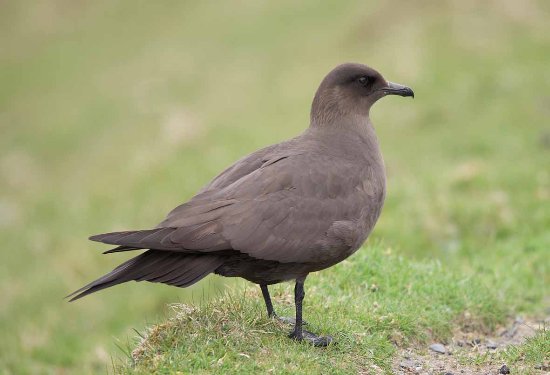
Arctic Skua
Photo Credit – Birds of the World
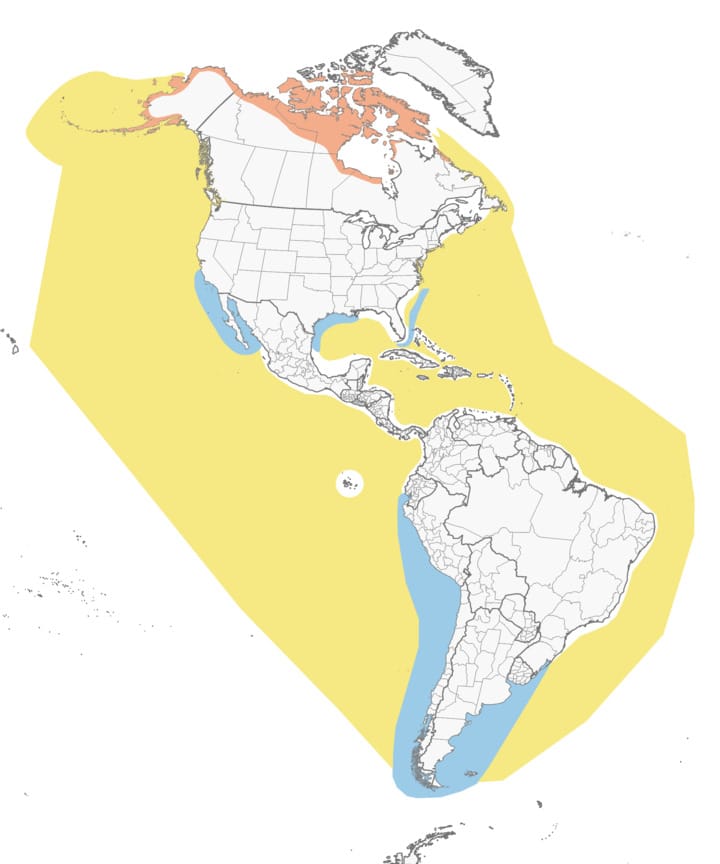
Parasitic Jaegers’ North America Range
Photo Credit – Birds of the World
Orange: breeding; Yellow: Migration; Blue: Winter

Arctic (Parasitic) Skua UK Distribution
Photo Credit – RSPB
Yellow: Breeding; Pink: Passage
As a teenager at Spurn Point, England, I spotted Arctic Skuas migrating off the coastline. They are distinguished by their strong wing beats and pointed wings, and I watched them chasing Sandwich Terns to rob them of their food. They breed in the high Arctic Tundra in northern Eurasia and North America and migrate south for winter as far as the Southern Hemisphere.
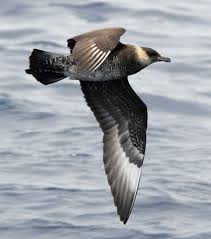
Pomarine Jaeger (Skua)
Photo Credit – Wikipedia
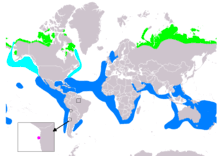
Pomarine Jaeger (Skua) Range
Photo Credit – Wikipedia
There were also sightings of Pomarine Skuas at Spurn Point. Sometimes referred to as the Pomeranian Skua, they have no connection with the Pomeranian area of the Baltic Sea. They are broad-winged and bulkier than the Arctic Skua, and they have darker plumage and a more methodical, direct flight pattern. The species nests in the Arctic Tundra in the far north of Eurasia and North America and migrates to the Southern Hemisphere for winter. The birds rely heavily on lemmings for their food during their breeding season.
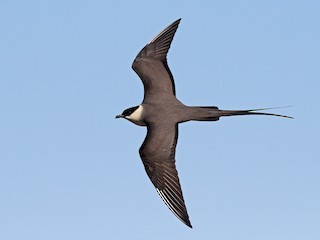
Long-tailed Skua/Jaeger
Photo Credit – eBird
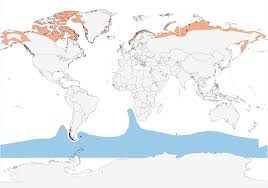
Long-tailed Skua/Jaeger Range
Photo Credit – Birds of the World
Long-tailed Jaegers are a third species of Jaeger that migrates along the California coast. In Europe, the Long-tailed Skua can be seen along Britain’s east coast and occasionally flies across the country during migration. It prefers to stay some distance out to sea. It is the smallest of the Skuas/Jaegers family, with thin, pointed wings and a graceful flight. It displays delicate, long tail streamers. Above, it is grayish and dusty below, with a pale breast and a dark cap on its head. In Eurasia, it breeds in the high Arctic and winters off the West African coast as far south as South Africa. In North America, they breed in the Arctic. They spend the remainder of the year at sea, reaching as far south as the Brazilian and Argentinian coasts and along the west coast of South America using the Pacific Ocean.
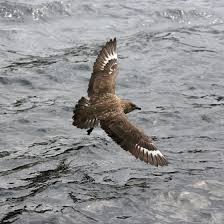 Great Skua
Great Skua
Photo Credit – British Trust for Ornithology

Great Skua Range
Photo Credit – Wikipedia
The only species that carries the name “Skua” in North America is the Great Skua, a large and aggressive bird that inhabits the North Atlantic area. I watched these birds migrate along Spurn Point, where some colleagues called them “Bonxies,” a Nordic word for corpulent. They breed in Iceland, Norway, the Faroe Islands, and the Scottish islands north of Great Britain and winter at sea.
They regularly appear along the northeast coast of North America, where they travel as far south as Brazil and South Africa. Adult birds are large, powerful, thick-necked, bulky, wide-winged, streaked greyish brown, with white wing flashes and a black cap. Their tail feathers are short and blunt. Their diet consists of fish, carrion, rodents up to the size of rabbits, and smaller seabirds. Their population is about 35,000 individual birds.
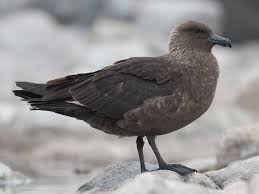
South Polar Skua
Photo Credit – eBird
Three Southern Hemisphere species carry the name Skuas, not Jaegers, and one winters as far north as the California coast. It is called the South Polar Skua. It breeds in the Antarctic from November to January and moves north to winter at sea in the Pacific, Atlantic and Indian Oceans. It does not reach as far north as the UK, although there is speculation that an occasional vagrant may have been mistakenly identified as a Great Skua.
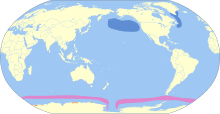
South Polar Skua Range
Photo Credit – Wikipedia
Their arrival along the California coast begins in southern California during late spring and reaches northern California by early fall. It is rare to see them from the shore since the preferred habitat is the open ocean, where concentrations of other birds are available to offer the opportunity for them to steal their food. Pelagic boat trips provide the best chance to spot this species. It is a large, brown Skua with white wing flashes.
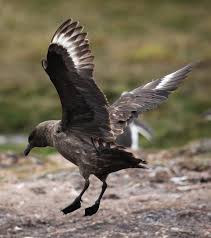
Brown Skua
Photo Credit – Wikipedia
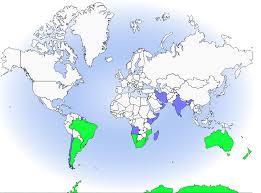
Brown Skua Range (blue = Rare vagrant)
Photo Credit – Oiseaux.net
Two other Skua species appear only in the Southern Hemisphere. The most widely spread is the Brown Skua, which ranges across the Antarctic and subantarctic and is seen off the coastlines of South Australia, New Zealand, South Africa, and South America. It is the largest and heaviest of all Skuas and is normally seen offshore, where birds may follow boats. Their plumage is dark brown, with broad white patches on the upper and underwings in flight.
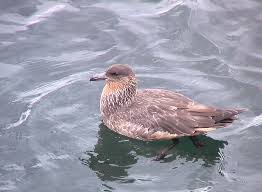
Chilean Skua
Photo Credit – Wikipedia
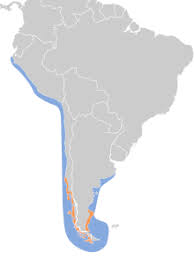
Chilean Skua Range
Photo Credit – Wikipedia
Orange = Breeding
Finally, the Chilean Skua’s territory is limited to South America. It inhabits coastal regions from central Peru southwards, through the Strait of Magellan, to northern Argentina, and some birds may reach Brazil during winter. It is also known as the Cinnamon Skua because of its conspicuous cinnamon-colored neck ring. The species displays a dark brown cap, gold upper breast, and cinnamon-colored underwing covers.
Calculating skua populations is challenging because of their remoteness from humans, but numbers appear stable. Reductions in food supply are the most significant risks. When lemmings are in short supply, the Long-tailed Jaeger will miss a breeding season. In the UK, the number of breeding Arctic Skuas has fallen 70 percent since 2000, possibly due to the decline of other seabirds that provide them with food. The lifespan of Skuas varies by species but typically falls between 10 to 25 years, with some birds living over 30 years.

South Polar Skua and Penguin Attack
Photo Credit – Jim Reisert
These are fabulous birds to watch as they chase other birds and display superior flight skills. Try to use location, size and plumage color to determine which species you are looking at. Remember, the most likely place to see them is a few miles offshore.



